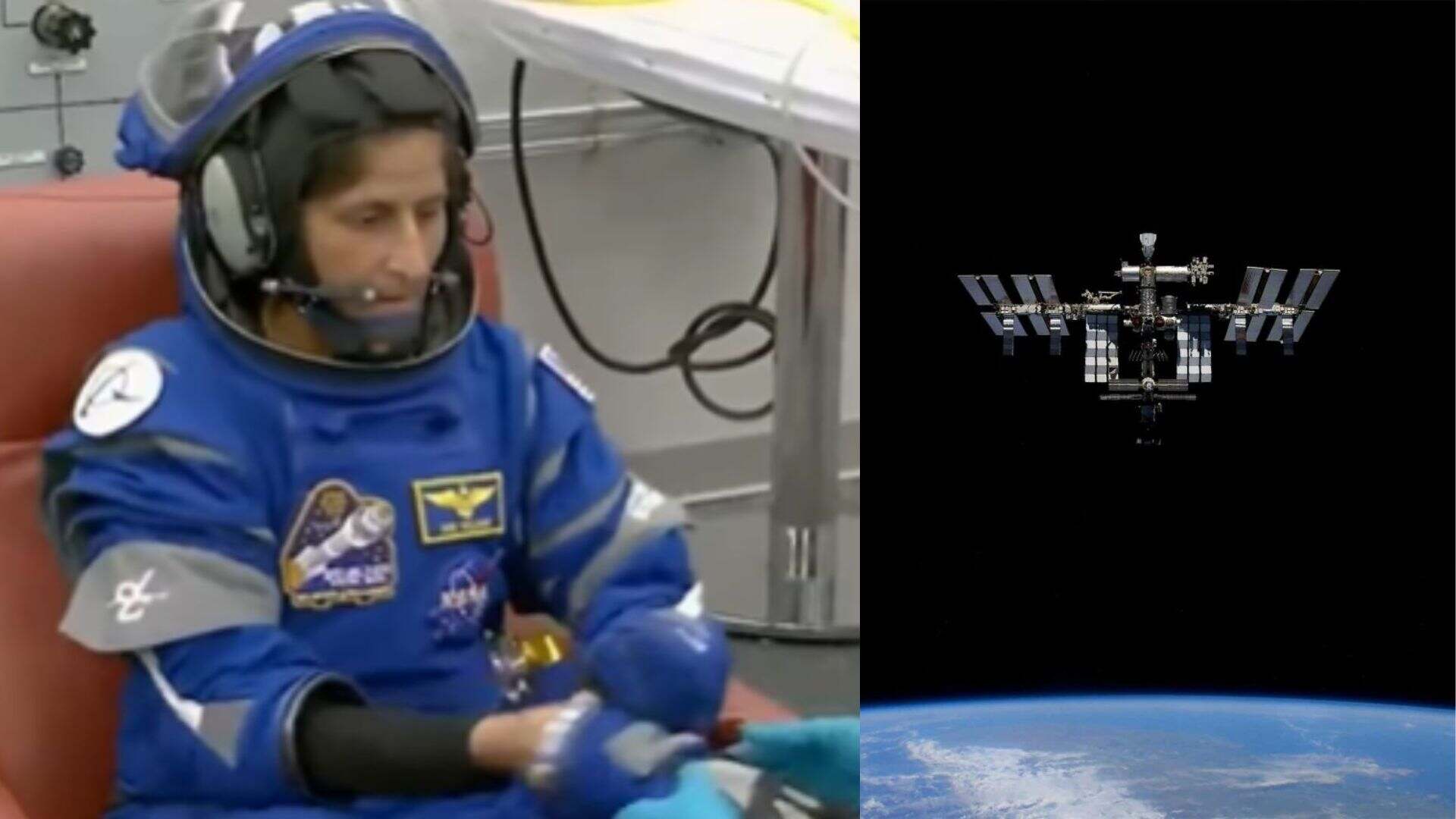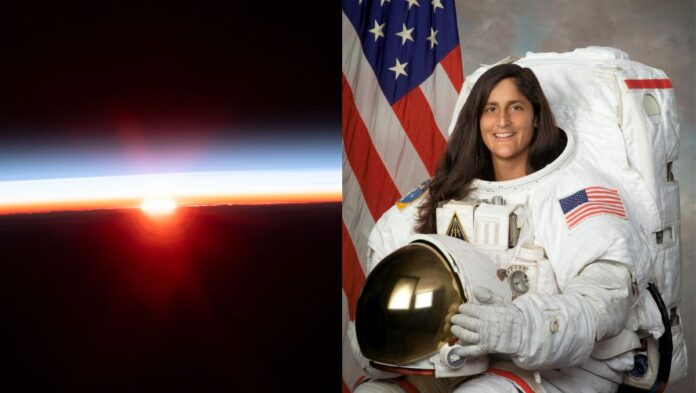One of the fascinating realities of life in space is the unique view of Earth’s daily rhythms. For astronauts like Sunita Williams, living on the International Space Station (ISS) means experiencing a staggering 16 sunrises and 16 sunsets every single day. This phenomenon might sound like something out of science fiction, but it’s a natural occurrence due to the speed and orbit of the ISS around Earth.
How the International Space Station Creates a Day Like No Other?
The ISS orbits Earth at an altitude of approximately 400 kilometers (250 miles) and travels at a speed of about 28,000 kilometers per hour (17,500 miles per hour). At this speed, the station completes one orbit around Earth in about 90 minutes. Consequently, within each orbit, the ISS crosses from the daylight side to the nighttime side of Earth, providing astronauts with a full cycle of day and night in a very short period.
This rapid orbit means that every 24 hours, the ISS completes approximately 16 orbits around Earth. As it circles the planet, astronauts aboard witness 16 sunrises and 16 sunsets, an awe-inspiring spectacle that offers them a constant reminder of the dynamic nature of Earth’s rotation and their unique position above it.

A Mesmerizing Sight: Witnessing Sunrises and Sunsets from Space
Astronauts like Sunita Williams often describe sunrises and sunsets from space as breathtaking experiences that they never tire of. From the ISS, these events unfold at incredible speeds. Unlike on Earth, where the sun seems to rise and set gradually, the view from space is much faster and more vivid.
At sunrise, astronauts can observe a thin blue line emerging on the horizon, marking the boundary between night and day. This line grows brighter and expands as the sun rises quickly, illuminating Earth’s atmosphere in stunning shades of blue and orange. Sunsets, on the other hand, reverse this spectacle as darkness rapidly consumes the daylight, casting Earth into shadow.
The colors of sunrises and sunsets from space are intensified due to the thin atmosphere the ISS travels through, creating vibrant displays of light. Astronauts capture these scenes whenever possible, sharing them with the world to showcase the beauty of Earth from above.
How Does This Affect Astronauts’ Daily Life and Routine?
Experiencing 16 sunrises and sunsets each day might sound exciting, but it poses unique challenges for astronauts’ daily routines and sleep schedules. To maintain a consistent schedule, astronauts on the ISS follow a coordinated universal time (UTC) and rely on structured “day” and “night” periods set by NASA.
Astronauts must adhere to specific sleep schedules, often using eye masks and other sleep aids to simulate darkness. They also use bright lighting to help regulate their circadian rhythms, which can be disrupted by the rapid cycle of day and night outside. While the view outside is spectacular, creating a stable internal environment helps astronauts stay mentally and physically healthy.

Why 16 Sunrises and Sunsets? The Science Behind It
The primary reason astronauts experience so many sunrises and sunsets lies in the speed at which the ISS orbits Earth. While Earth completes one full rotation in 24 hours, the ISS, traveling at such a high velocity, completes one orbit in just 90 minutes. This pace allows astronauts to witness the entire day-night cycle 16 times over.
From the ground, Earth’s rotation gradually brings different areas into sunlight and darkness, creating day and night. In space, however, the ISS travels around Earth much faster than Earth rotates, creating the appearance of multiple day-night cycles. The orbital mechanics that enable this phenomenon underscore the incredible speed and positioning of satellites and spacecraft in low Earth orbit.
The Psychological Impact of Constant Sunrises and Sunsets
Witnessing sunrises and sunsets so frequently can be a surreal experience, but it may also have psychological effects. For some astronauts, the beauty and rapid cycle are inspiring, reminding them of Earth’s vastness and the unique nature of space travel. However, the constant change in light can be disorienting, especially during long missions, when the monotony of repetitive day-night cycles becomes challenging.
Astronauts are trained to handle these conditions and often report that the privilege of seeing Earth from space outweighs any drawbacks. The views, combined with the understanding of how interconnected Earth’s ecosystems are, give astronauts a profound appreciation for our planet, often referred to as the “overview effect.”

The Overview Effect: A Profound Shift in Perspective
The overview effect is a psychological phenomenon reported by many astronauts, including Sunita Williams, who have viewed Earth from space. This effect is characterized by a heightened sense of awareness, interconnectedness, and a new perspective on humanity and the planet. Witnessing Earth as a fragile blue sphere floating in the darkness of space can evoke strong feelings of unity, compassion, and environmental responsibility.
For astronauts observing Earth’s rapid sunrises and sunsets, the overview effect can be profound. They witness the thinness of Earth’s atmosphere, the curvature of the planet, and the vast expanse of space surrounding it. This experience often leads astronauts to advocate for sustainability and environmental consciousness, recognizing the importance of protecting the only home humanity has.
NASA’s Future Space Missions and What It Means for Astronaut Life?
NASA continues to explore ways to improve astronaut life in space, particularly as the agency prepares for longer missions, such as those planned for the Moon and Mars. For extended missions, managing sleep cycles and the psychological impact of isolation will be crucial. NASA is exploring options like specialized lighting systems and virtual environments to simulate natural light and improve mental well-being.
As space exploration advances, future astronauts on the Moon or Mars may not experience the same rapid cycle of sunrises and sunsets. Mars, for example, has a day that lasts approximately 24.6 hours, similar to Earth’s, but with very different light conditions. The ISS, however, will remain a unique setting, providing views of Earth’s dynamic, rapidly changing horizon.

A View Like No Other
Sunita Williams and her fellow astronauts are among the few privileged to witness Earth’s stunning beauty and dynamic cycles from above. The experience of 16 sunrises and sunsets each day is a constant reminder of the incredible science and exploration that allows humans to inhabit space. As NASA and other space agencies work to make space travel safer and more comfortable, the sights and sensations experienced on the ISS remain unparalleled.
These repeated views serve as both a scientific marvel and a source of inspiration, highlighting Earth’s beauty and reminding us of the importance of preserving our planet. For those of us grounded on Earth, Sunita Williams’ journey is a window into the awe-inspiring reality of space travel, encouraging us to look up and appreciate the vastness of the cosmos above.

